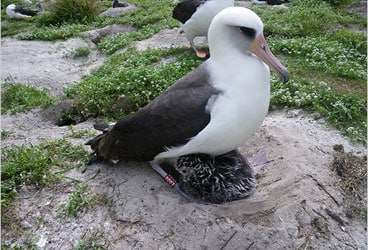_And a good south wind sprung up behind;
The Albatross did follow,
And every day, for food or play,
Came to the mariner’s hollo!
_
“The Rime of the Ancient Mariner,” Samuel Taylor Coleridge
If there’s one bird sailors revere above all, it’s the albatross: for its grace in flight, its comforting presence above the loneliest waters of the planet, its ability to serenely traverse thousands of miles of open ocean.
Sailors should care about the fate of this great bird that somehow captures the freedom and independence of life on the ocean wave, and there are plenty of reasons—flotsam, long lines, pollution—to fear for its future. Collectively, we are the Ancient Mariner, and we should remember what happened to that misguided salt when he shot the Albatross.

www.wikipedia.com
_The remains of this Laysan Albatross chick show the plastic ingested before death, including a bottle cap and lighter.
_
Earlier this month, I saw a story that only reinforced my respect for the remarkable qualities of this remarkable bird. It was about a female albatross living at the Midway Atoll National Wildlife Refuge. Scientists estimate her to be about 60 years old—which makes her the oldest bird known in the United States—and she has succeeding in hatching yet another chick. Albatrosses lay one egg a year; this new chick is believed to be the latest in a string of more than 30. The bird’s name is Wisdom. How can that not make you smile, not give you hope?

www.nytimes.com
_Whew, that’s another one!
_
But the world is a complicated place. That joy turned to sadness after the earthquake in Japan. The deadly tsunami it threw up not only devastated human lives, it swept east across the Pacific and inundated the Midway Atoll along the way. Midway is home to Wisdom for a reason: it happens to be a prime breeding ground for Albatrosses. Tragically, the tsunami caught them at the worst moment possible—in the midst of their breeding season, after the birth of chicks but before the chicks were old enough to fly.

www.fws.gov
_Tsunami Inundation: Spit Island—100% washed over. Eastern Island—60%; Sand Island—20%
_
The tidal wave was devastating to the bird colonies and other wildlife living on Midway. It’s possible that tens of thousands of chicks were swept away. It’s impossible to know the full impact on the albatross population of this extreme act of nature, but it’s nice to know that everyone on Midway Island is doing their best to rescue chicks and preserve those that are still alive.

Here’s hoping the albatrosses of Midway somehow recover, so that we can continue to see this beautiful sight from small boats on large oceans:









